The Russian Avant-Garde
back to Symbolism (7 - 11)
The ideological unity of the symbolist aesthetic had already begun to show strains by 1906
(we will discuss these in our examination of Alexander Blok's play "The Fairground
Booth"). In symbolism's wake came a dizzying series of ephemeral avant-garde
movements, most of which defined themselves by overt opposition to the precepts of the
symbolists. Nevertheless, all of these movements grew out of symbolism and, whatever
they may have claimed, they owed a great deal to it. In painting, by around 1907 the soft
aestheticism of symbolist art gave way to a primitivist school headed by Mikhail Larionov
(1881-1964), and his wife, Natalia Goncharova (1881-1962). Both were well aware of
post-impressionist tendencies in France, and were particularly impressed with the later
work of Paul Gauguin and the Fauves. This they combined with an appreciation of
Russian folk, popular, and religious art--including the "lubok" (popular woodcuts) and
traditional peasant crafts including carving and embroidery--to produce a highly
provocative and original aesthetic.
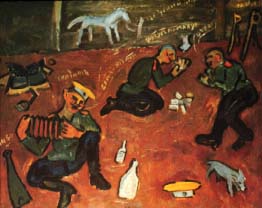 #12
#12
Larionov's service in the Russian army provided the inspiration for a
whole series of soldier paintings, including this one of 1909. Note Larionov's deliberate
distortion of perspective and his use of words on the canvas to create a miniature dramatic
scene.
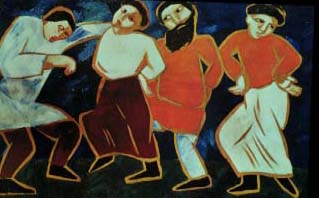 #13
#13
The talented Natalia Goncharova captures the atmosphere of the Russian peasant
milieu beautifully in her "Peasants Dancing" (1911). Even more than Larionov,
Goncharova was heavily indebted to the techniques of Russian icon painting, from which
she borrowed the heavy drapery covering her figures, their stylized facial expressions, as
well as their monumentality. This work is said to have had an important influence on
Malevich's primitivist work (#14).
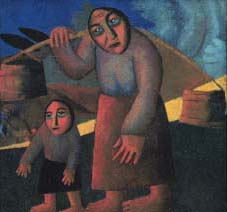 #14
#14
Kazimir Malevich (1878-1935) was perhaps the most fertile and
influential of the Russian post-symbolist visual artists. In the period 1909-1912, he, like
Larionov and Goncharova concentrated on peasant scenes (he had grown up in the rural
Ukraine), rendered in a heavy, primitivist style. In "Peasant Woman with Buckets and
Child" (1912) Malevich's palate and the angularity of his faces recall the work of Paul
Gauguin, but the grotesque poses and weighty bodies take primitivism even further.
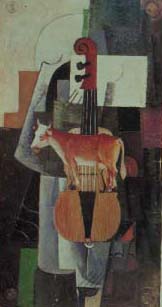 #15
#15
By 1913, Malevich was experimenting with cubist compositions
clearly inspired by Picasso, whose early cubist work was well known to Russian artists
through the impressive holdings of the Moscow collector Sergei Shchukin as well as
through numerous reproductions in the leading Russian journals. As always, however, the
Russian avant-garde artists did not merely imitate their French contemporaries. The
Russian avant-garde painters of this inclination called themselves cubo-futurists, to signify
their synthesis of cubist technique and futurist ideology. Malevich's composition in "Cow
and Violin" (1913) differs sharply from Picasso's work both in its more colorful palate
and in its playful use of an entire miniature cow superimposed on the fragmented
instrument. The latter lends Malevich's painting a humorously grotesque note absent in
Picasso's more analytic canvases. In this same year, Malevich designed his pathbreaking
sets and costumes for the futurist opera "Victory Over the Sun" (see illustrations #53, 54, 55,
55a )
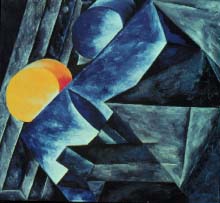 #16
#16
By 1913, Natalia Goncharova, too, had moved from primitivist to completely non-
objective painting. This "Abstract Composition" still contains her typically bright palate,
but it no longer refers even nominally to any external reality. It is, rather, an example of
pure painting for its own sake.
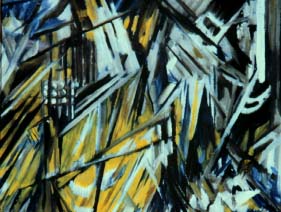 #17
#17
In 1913, Larionov and Goncharova developed what may have been the
first original Russian school of non-objective painting, Rayonnism. According to the first
Rayonnist manifesto, written by Larionov and Goncharova in 1913, "The style of
Rayonnist painting that we advance signifies spatial forms which are obtained arising from
the intersection of the reflected rays of various objects, and forms chosen by the artist's
will. The ray is depicted provisionally on the surface by a colored line. That which is
valuable for the lover of painting finds its maximum expression in a rayonnist picture. The
objects that we see in life play no role here, but that which is the essence of painting itself
can be shown here best of all--the combination of color, its saturation, the relation of
colored masses, depth, texture." (for a full text, see Bowlt, pp. 87-91). Like cubism,
however, the non-objectivity of rayonnism initially grew out the analytic deconstruction of
real objects, evolving gradually into pure abstraction, as in this composition of Larionov
which probably dates from 1913.
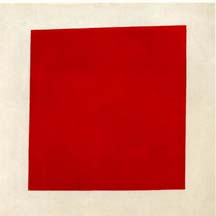 #18
#18
Working in parallel, Malevich also created a system of abstract painting that
he would call suprematism. Unlike cubism and rayonnism, suprematism did not gradually
evolve from figurative painting. Rather, it began abruptly with the production of stark,
geometrically-organized canvases like "Red Square" (1913). Of this style, Malevich said
in his treatise "From Cubism and Futurism to Suprematism: The New Painterly Realism"; "I
have transformed myself in the zero of form and have fished myself out of the rubbishy
slough of academic art.. I have destroyed the ring of the horizon and got out of the circle
of objects, the horizon ring that has imprisoned the artist and the forms of nature." (For a
fuller text, see Bowlt 116-135) Malevich's suprematism was already apparent in his
designs for the Futurist opera "Victory Over the Sun", 1913 (see illustrations #53, 54, 55,
55a )
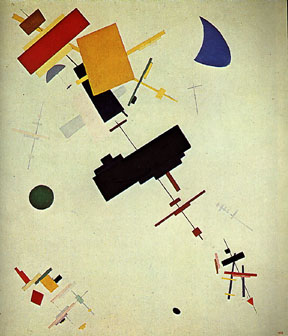 #19
#19
From the simplest geometric, monochrome shapes, Malevich built an
entire suprematist universe in a series of stunning canvases like this composition painted
around 1916. Unlike Goncharova and Larionov, Malevich remained in the Soviet Union
after the Revolution. In the first years after 1917, he held a series of major teaching posts
in Moscow, Petrograd, and Vitebsk. There he tried to systematize the insights he had
gained in his suprematist period, and apply them to the creation of a scientific school of art
teaching and production.
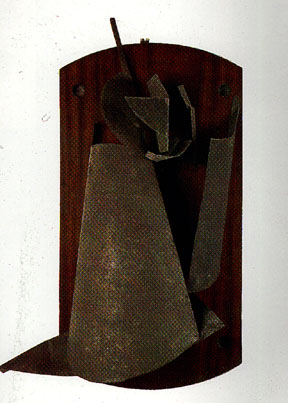 #20
#20
While Larionov, Goncharova, and Malevich worked almost exclusively
on canvas, Vladimir Tatlin (1885-1953) achieved his greatest success in three-dimensional
media, often using materials salvaged from scrap or chosen for their specific texture as
well as shape. Like Malevich, Tatlin was interested in material as such, rather than in
imitating any external objects. This relief (1916) is typical of Tatlin's early abstract work.
Sculptures such as this had a crucial influence on the Constructivist movement after the
Russian Revolution. See also see how Tatlin's early reliefs were transferred to the stage in
his designs for the 1923 production of "Zangezi" (illustrations #67-69)
 #12
#12
 #13
#13
 #14
#14
 #15
#15
 #16
#16
 #17
#17
 #18
#18
 #19
#19
 #20
#20